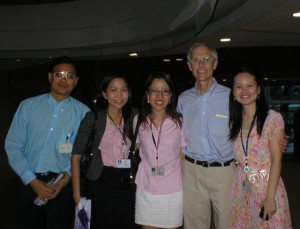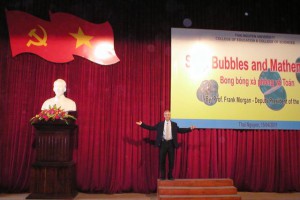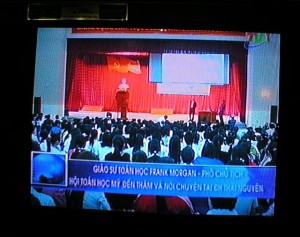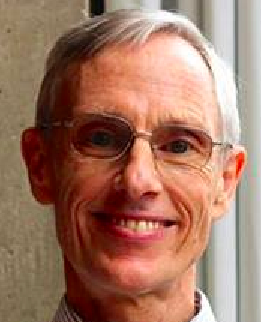Archive for the ‘General interest’ Category.
28th April 2011, 06:35 am
There seem to be no obstacles to progress in Thailand: everything is for sale. The streets of Bangkok are crowded with vendors of all kinds of food and clothing and services. If you need soap bubbles for your talk, you can find them at Toys R Us. If you need computer repair because you spilled soap bubbles on your new MacBook Air during your talk, there are even some ten authorized Apple repair shops, as in the famous Pantip Plaza, which also boasts three Apple sales shops. If you want to try durian ice cream despite the smell, it’s available at the nearest Metro station. If you want to visit some temples, you can hire a tuk-tuk for an hour for 30 Baht = $1, as long as you’re willing to visit a sponsoring tailor shop on the way.
The first three pictured former students treated me to dinner at In Love restaurant by the river.


Harit Rodpraser, Aom Kitichaiwat, Ta Banchuin, and Rungporn Roengpitya work at the Bank of Thailand. I found them through former student Chung Truong, pictured here at his penthouse room, who just showed up at my talk in Ho Chi Minh City. Continue reading ‘Shopping in Thailand (and ICMA-MU Dec 2011)’ »
20th April 2011, 03:59 am
Mathematics is prospering in Vietnam, supported by the latest technology. Most classrooms have built-in computer projection, and they readily supply document cameras and wireless lavaliere mikes. The internet is reliable and readily available. They’ve even figured out how to block Facebook.


Talk on “Soap Bubbles and Mathematics” to 1000 students in Thai Nguyen covered on TV.
Also see TV coverage of Hue talks.
4th April 2011, 01:16 pm
When friends hear that I’m on a math visit to Pakistan, they often say something about safety. Actually, despite heightened security, I’ve felt completely safe and at home here. The culminating experience was setting up my computer well before talks at QAU, NUST, and GCU* and finding I could leave it unattended, rarely the case in the US or anywhere else.
Incidentally, as of 2008-09, 46% of undergraduates in Pakistan are women, up from 37% in 2001-02. During this period total enrollment has more than doubled. Similarly 31% of PhD students are women, up from 20%.
*See the article by Loring Tu on the GCU “Abdus Salam School of Mathematical Sciences in Pakistan” in the August 2011 Notices of the American Mathematical Society.
15th March 2011, 07:00 am
[“Soap Bubbles and Mathematics,” written for the Spanish Math Carnival]
¿Por qué son las pompas de jabón tan perfectamente redondas?

Continue reading ‘Pompas de Jabón y las Matemáticas’ »
20th February 2011, 02:50 pm
Category:
General interest |
Comments Off on Thurston to Speak at Bridges Conference in July
25th June 2010, 07:26 am
At an AWIS–NSF meeting in DC, I am learning about implicit bias, that none of us see things objectively, as in the following amazing optical illusions:
The Tables
The Checkerboard (and video)
Squares
Spinning Woman
T-Rex
The following human figures on the left are exactly the same color and shade as those on the right:

For information on similar gender biases, see the brochure by WISELI on “Reviewing Applicants.”
Note added 25 May 2011. AWIS has posted some webcasts. One study found that readers of CVs identical except for a man’s or a woman’s name at the top preferred to hire the man. The same study found no such difference for tenure decisions.
14th May 2010, 07:49 am
We give an oversimplified argument that an amateur investor with capital V should rebalance holdings every

years.
24th January 2010, 08:30 am
In reading prefaces to various works collected in the Harvard Classics (limited edition set no. 1312, purchased by my grandfather but never read, so that I had to slit open the folded pages with a knife), I was struck by the clarity and scope of the preface to Newton’s Principia. Newton announces an explanation of “the system of the World” by deducing the planetary orbits and the terrestrial tides by calculus from his new law of gravity. Then he says he wishes he could similarly derive “the rest of the phenomena of nature” from as yet undiscovered laws of attraction and repulsion between small particles. In the last sentence quoted below he explains how he deals with what was an annoying problem for writers before TeX. Continue reading ‘Newton’s Principia’ »
29th October 2009, 05:46 am
Note added 13 June 2017: see a video featuring Prof. Johnson at the NESN Clubhouse.
In his senior colloquium last fall advised by Frank Morgan, Davide Carozza ’09 investigated the fastest path around the bases in baseball, assuming a bound of say 10 ft/sec2 on acceleration/deceleration. Following the baseline, stopping at each base, takes about 22.2 seconds. The standard recommended “banana” path follows the baseline maybe halfway to first base and then veers a bit to the right to come at first base from a better angle to continue towards second. That cannot be ideal. It would have been better to start at an angle to the right to head directly to an outer point on the banana path. Davide found that a circular path at 17.8 seconds is roughly 20% faster than following the baseline at 22.2 seconds. Stewart Johnson then computed the following optimal path at 16.7 seconds. The record time according to Guiness is 13.3 seconds, set by Evar Swanson in 1932 (with larger acceleration than our assumed 10 ft/sec2).
19th May 2009, 03:41 pm
Guest post by Lee Newberg [but see Comment below]
I stumbled across an old Math Chat column of yours, which mentioned that the number of ways to make change for a dollar is the coefficient of  in the Taylor expansion of
in the Taylor expansion of
 .
.
But I don’t see there, or anywhere on the web, the general formula for the number of ways c(n) to make change for n dollars. In case you are interested, below I derive it to be:
 .
.
Spending 1 trillion dollars with the federal stimulus means that Obama has
 = 13 333333 333398 333333 333445 333333 333413 833333 333354 500000 000001
= 13 333333 333398 333333 333445 333333 333413 833333 333354 500000 000001
ways to make Change for America. Continue reading ‘Making Change for America’ »







 Welcome to my blog. I also have a blog at the
Welcome to my blog. I also have a blog at the